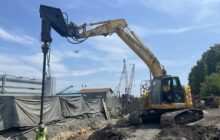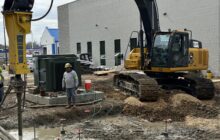
Ductile Iron Piles provided a low vibration foundation solution to support the new foundations in the highly variable ground conditions.
Project Description:
Construction consists of a new 3-story office building on a 6,500 square foot lot. The building includes an at-grade parking level followed by 2 stories of office space above. Column loads ranged from 120 kips to more than 600 kips. A nearby “Little Pond Conduit” utility easement was located along the western property line.
Geotechnical Conditions:
Soil conditions were highly variable across the small site footprint. Heterogeneous “urban” fill consisting of sand, silt and gravel as well as wood, ceramics, concrete, asphalt, ash cinders, brick, rubber and other materials ranged from 16 to 28 feet below grade. The fill was underlain by soft organic soils (peat and organic silt) ranging in thickness from 9 to 26 feet. Interbedded silty clay and sand was encountered below the fill and organics and exhibited N-values ranging from WOH to 72 bpf. Glacial outwash (sand and gravel) were then encountered at depths of about 60 to 83 feet below grade followed by weathered bedrock at depths ranging from 87 to 111 feet.
Project Challenges:
Provide low vibration foundation solution to support the new foundations in the highly variable ground conditions.
Advantages
- Low vibrations
- No depth limitations to allow penetration through unsuitable soils
- Medium-duty excavators limited extensive working pad construction
- Ability to work on constrained sites
- Demonstrated capacity through load testing
Design and Construction Solution
Previously, Ductile Iron Piles were successfully used to provide a low-vibration foundation support solution for the nearby laboratory building at 42 Spinelli Place. As the same project team planned for a new building within the Spinelli Place complex, the geotechnical engineer recognized the value added by the Ductile Iron Piles. In addition to providing low vibration foundation support, the DIP system could easily be installed to variable depths to penetrate the unsuitable conditions and address the site variability.
Ductile Iron Piles were specified with a working capacity of 62 kips along with an ultimate downdrag allowance of 35 kips. Helical Drilling, Inc. (Helical) developed an approach using Series 118/7.5 piles with a 220 mm (8.6 inch) diameter grout shoe to construct an 8.5-inch exterior grouted displacement pile. A bond length of 17 feet in the glacial outwash sands was assumed. Pile lengths were initially anticipated to range from about 67 to 87 feet.
Upon mobilization to the site, Helical installed a load test pile along with four DIP reaction piles. The test pile included a 1-1/4” centerbar with four (4) Geokon strain gauges to estimate the load in the pile at depth. The test pile was installed to a depth of 89 feet below grade. The four reaction piles were installed to a depth of 64 feet. Per the specification, the full-scale compression load test was performed to 200% of the design load (124 kips) plus the ultimate downdrag load of 35 kips for a maximum test load of 159 kips. A deflection of 0.56 inches was recorded at the maximum planned test load of 159 kips. The net deflection remaining after the rebound was only 0.13 inches. To further evaluate pile performance and verify adequate load transfer through the unsuitable soils to the competent bearing layer, the test pile was re-loaded up to 280% (224 kips) at which point the strain gauge data confirmed the transfer of at least 150% of the design load to the bond zone. At 224 kips, the test pile deflected a total of 0.93 inches followed by a net deflection of only 0.22 inches after unloading.
Following the successful load test program, Helical installed a total of 92 production piles in only 8 days. The pile lengths ranged from 64 to 85 feet. With overall installed footage of 6,690 LF, average production rates were over 800 LF/day.
Project Team Members
DIP Design/Build Partner: Helical Drilling
Geotechnical Engineer: GZA GeoEnvironmental
General Contractor: Sea-Dar Construction
Structural Engineer: LeMessurier





